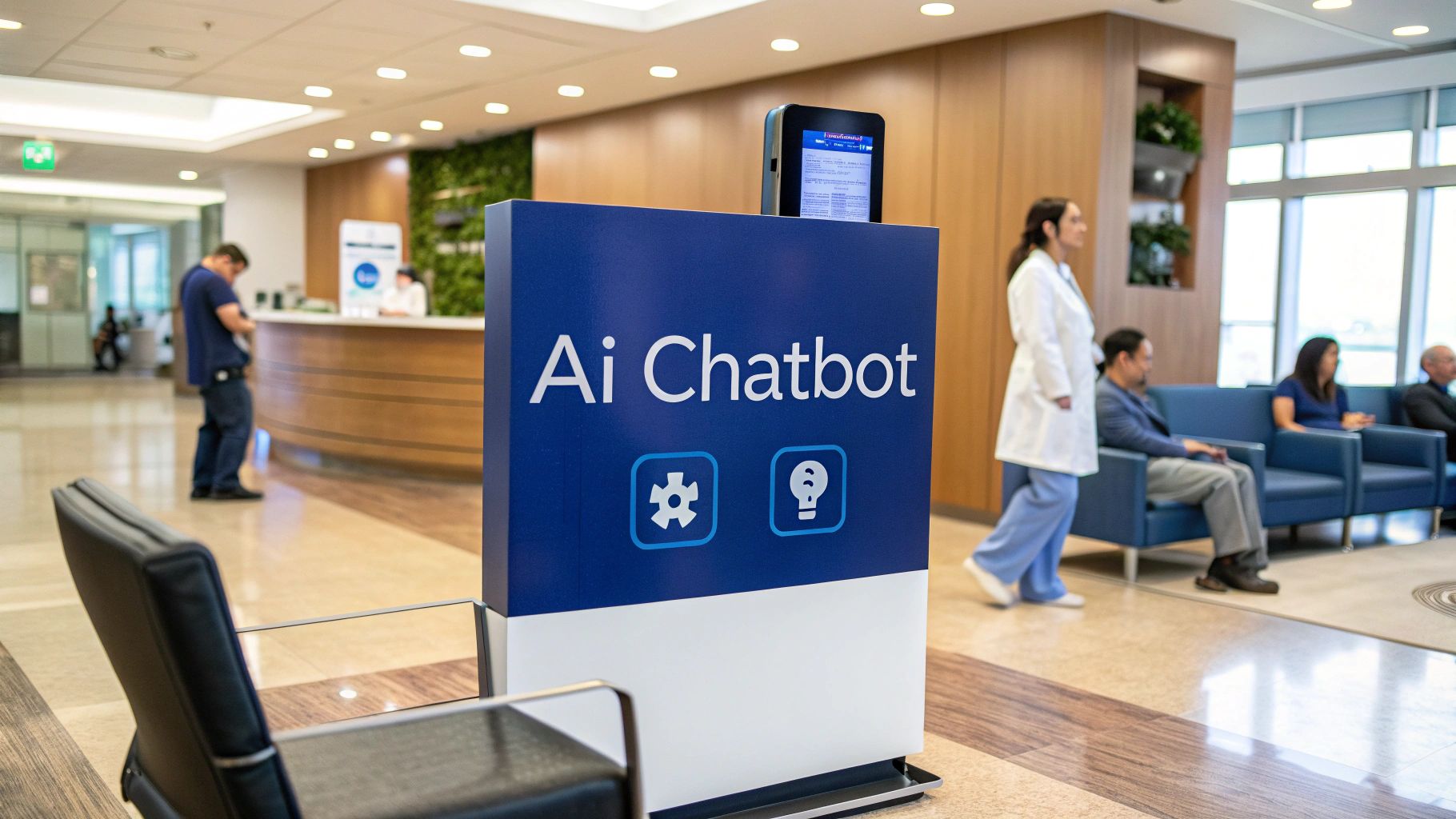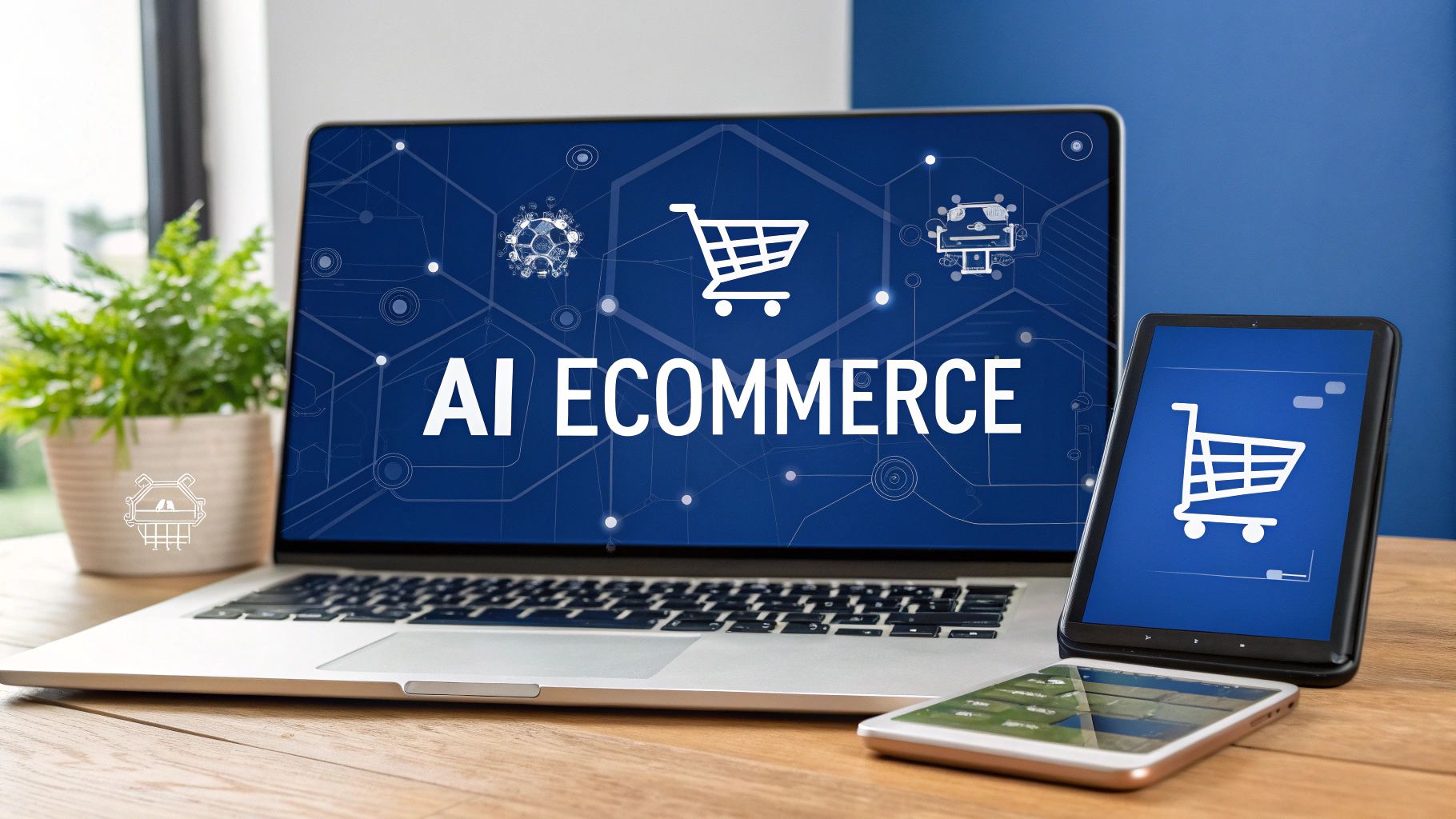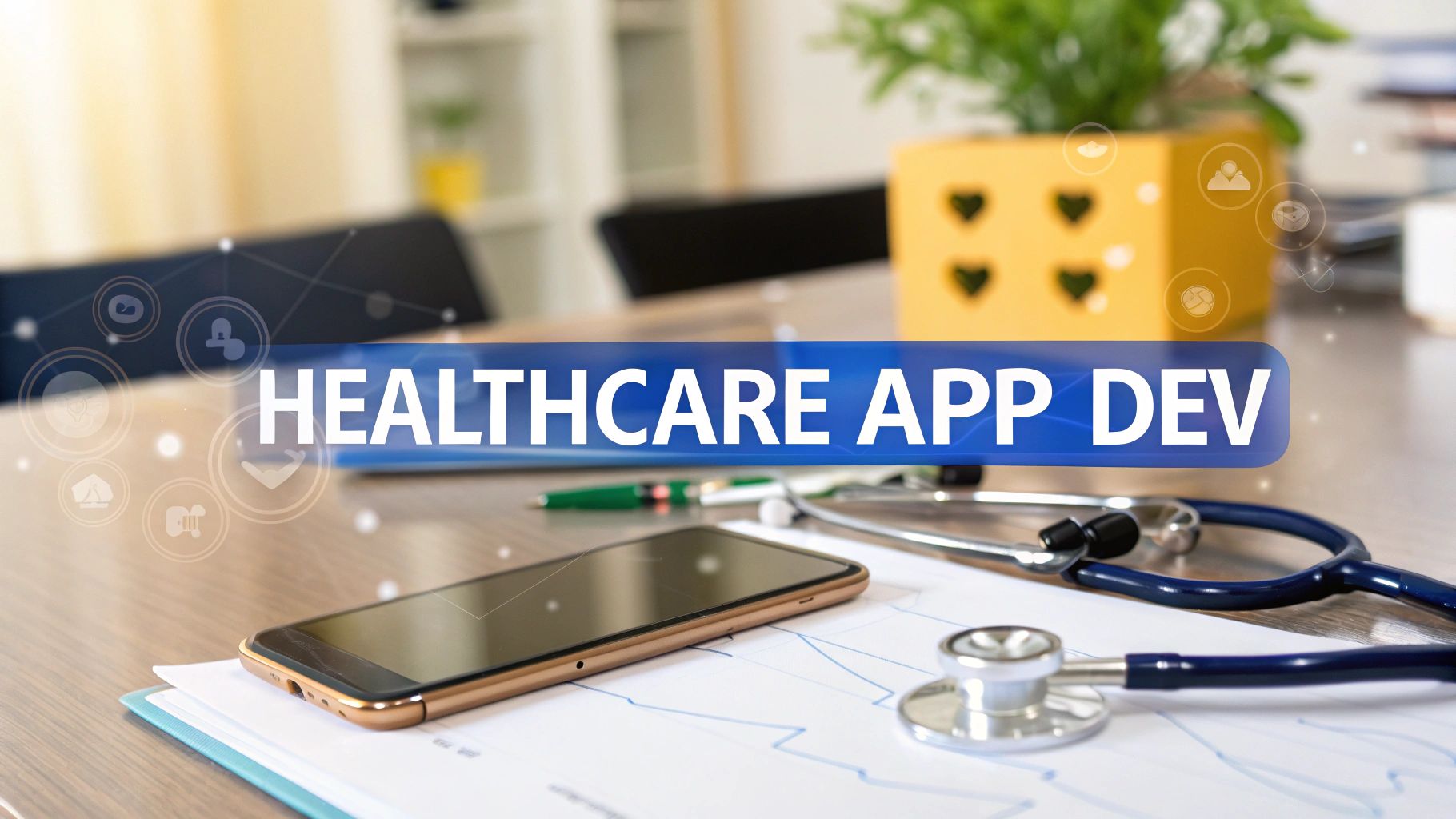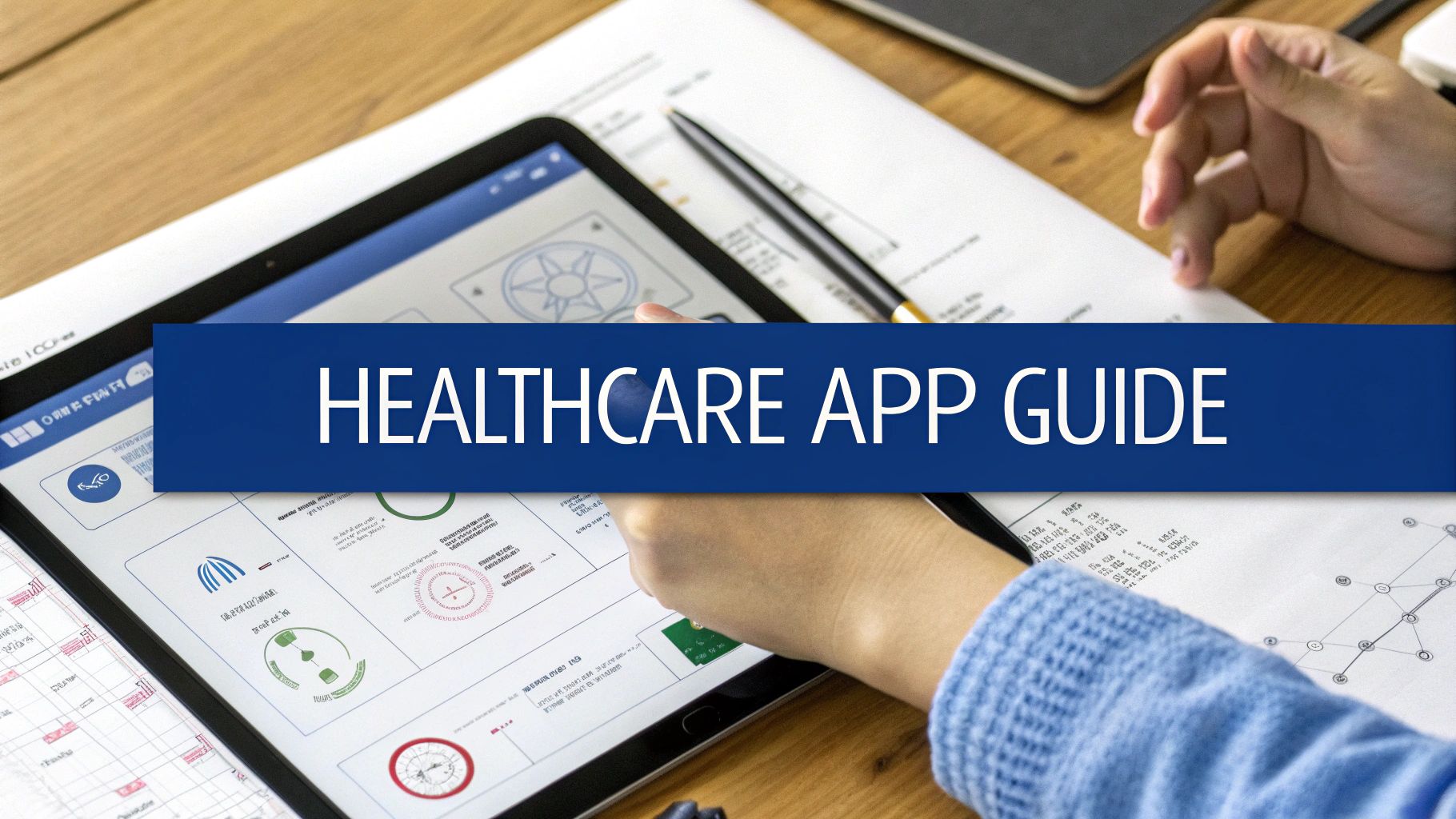An AI chatbot in healthcare is essentially a virtual assistant built to manage patient questions, book appointments, and offer up-to-the-minute medical information. You can think of it as the new digital front door for modern clinics and hospitals, providing instant, 24/7 support without needing a person on the other end. It’s a smart way to handle routine tasks, freeing up medical professionals to focus on more complex patient care.
The New Digital Front Door for Patient Care
Today's healthcare providers are stretched thin. They're trying to meet sky-high patient expectations while juggling an enormous amount of administrative work. Patients want faster answers and quicker access to care, but staff is often swamped with paperwork and scheduling headaches. This is precisely where an AI chatbot in healthcare stops being a futuristic idea and becomes a practical, much-needed tool.
Imagine it as the digital receptionist for your local clinic. Instead of a patient getting stuck on hold just to ask about opening hours or schedule a check-up, they can get an instant response from a chatbot on the clinic's website. The tool is designed to be that first, friendly point of contact, smoothly guiding patients to the right information or service.
This infographic helps visualize how AI chatbots are stepping in as the main entry point for patient interactions, much like a digital reception desk.
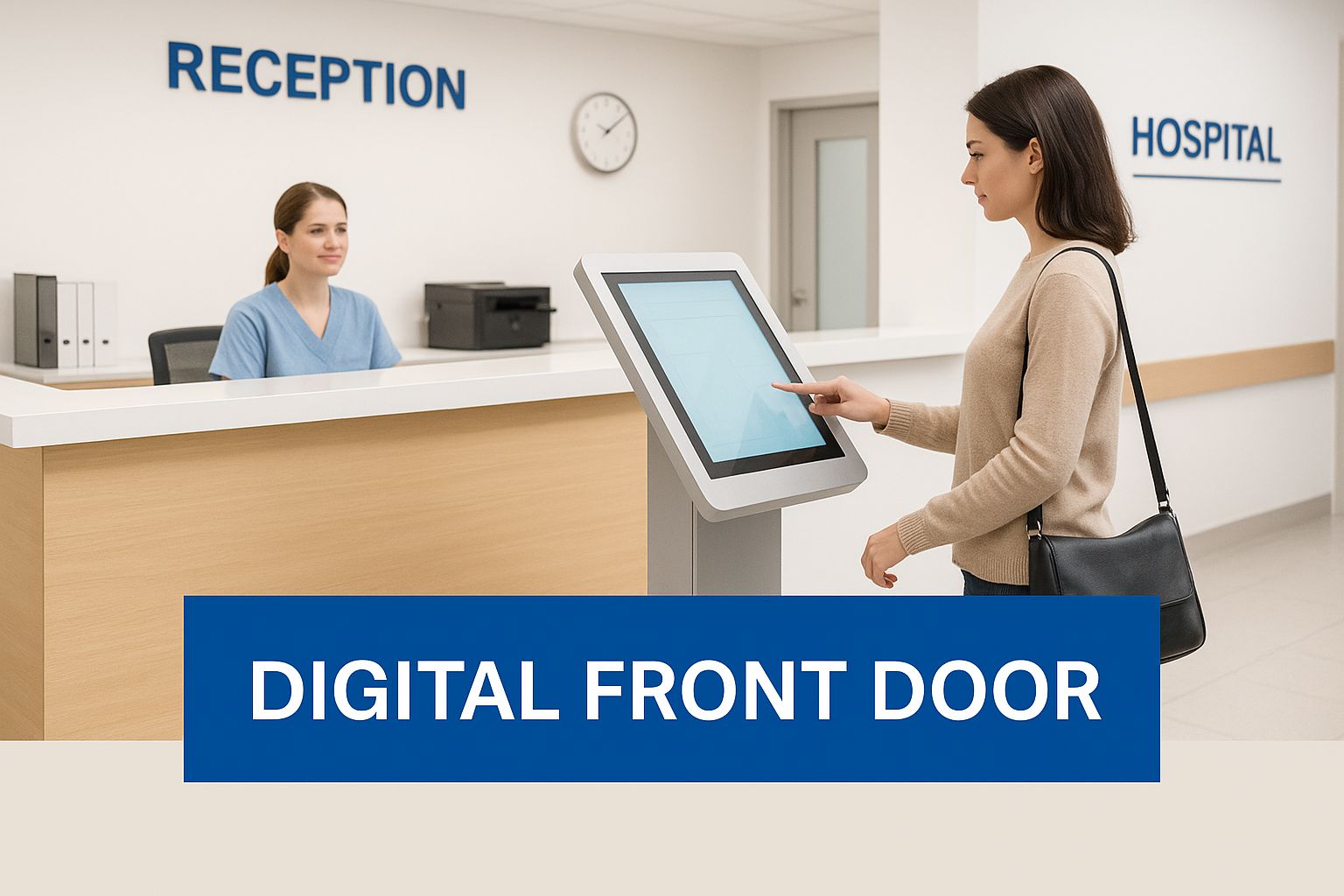
As the image shows, this technology creates a much more direct and accessible path for patients starting their healthcare journey.
Redefining the Patient Experience
The main purpose of this "digital front door" isn't to get rid of human interaction, but to make it better. By taking over repetitive, time-sucking tasks, these chatbots give precious time back to nurses, doctors, and admin staff. This simple shift lets healthcare professionals concentrate on what they do best: delivering compassionate, high-quality care to patients.
For instance, a single chatbot can handle hundreds of prescription refill requests at the same time, a task that would otherwise clog phone lines and overwhelm staff. That kind of efficiency leads to a smoother operation and helps reduce administrative burnout, which is a massive issue in the healthcare field.
The core benefit is clear: AI chatbots manage the predictable, high-volume inquiries, empowering human staff to handle the complex, nuanced aspects of patient care that require critical thinking and empathy.
This smart division of labour makes the whole healthcare system more responsive and efficient. The AI chatbot becomes a vital tool that not only makes things easier for patients but also supports the well-being of the medical team. Ultimately, it helps create a more sustainable way for modern healthcare organisations to operate.
Here is the rewritten section, designed to sound completely human-written and natural.
How AI Chatbots Understand What Patients Need
To really get why an AI chatbot in healthcare is such a big deal, you have to see how different it is from the more basic chatbots you might be used to. A standard chatbot is a bit like an automated phone menu, it gives you a few options and only understands specific keywords. An AI-powered medical chatbot, on the other hand, is more like a skilled triage assistant, ready to listen and respond to what a patient is actually saying.
This isn't magic; it's a technology called Natural Language Processing (NLP). NLP is what gives the chatbot the ability to grasp the subtleties of human language, whether someone is typing a question or speaking to a virtual assistant. It can figure out what you mean, recognise medical terms, and understand the context of the conversation.
So, a patient doesn't have to use perfect clinical jargon. They can just describe their symptoms as they would to a person, "my stomach has been hurting for two days, and I feel nauseous", and the AI can make sense of it to offer genuinely helpful guidance.
The Brains Behind the Conversation
At its core, an AI chatbot’s intelligence comes from its ability to process our messy, unstructured language. This happens through a few key steps that turn a patient's question into a meaningful response.
-
Intent Recognition: First, the chatbot figures out what the patient is trying to do. Are they trying to book an appointment? Ask about medication side effects? Or get help with symptoms?
-
Entity Extraction: Next, it picks out the crucial details from the message, like the specific symptom ("headache"), how long it's been happening ("three days"), or a medication name ("ibuprofen").
-
Sentiment Analysis: The AI can even get a sense of the user’s emotional state, like urgency or anxiety. This helps it prioritise requests or flag when a human needs to step in.
This level of analysis is what allows the chatbot to go beyond simple keyword matching and have a much more useful conversation. The demand for this technology is exploding; the global healthcare chatbots market, valued at around USD 1.49 billion, is expected to climb to USD 10.26 billion by 2034. This growth is being fueled by the rise of telemedicine and patients wanting instant access to virtual health support. You can explore more about the healthcare chatbots market growth on towardshealthcare.com.
To better understand the technology, let's compare the simpler bots with their more advanced AI counterparts.
Comparing Chatbot Technologies in Healthcare
The table below breaks down the key differences between a basic, rule-based chatbot and a sophisticated AI-powered conversational agent in a medical setting.
|
Feature |
Rule-Based Chatbot |
AI-Powered Chatbot |
|---|---|---|
|
Understanding |
Follows pre-programmed scripts and recognises keywords. |
Uses NLP to understand context, intent, and natural language. |
|
Conversation Flow |
Rigid and linear; often feels like a flowchart. |
Flexible and dynamic; can handle complex, multi-turn conversations. |
|
Learning Ability |
Static; requires manual updates to its rules. |
Learns and improves from interactions over time (Machine Learning). |
|
Personalization |
Offers generic, one-size-fits-all responses. |
Provides personalised responses based on user history and context. |
|
Use Case Example |
Answering simple FAQs like “What are your clinic hours?” |
Conducting a preliminary symptom assessment or triaging patient concerns. |
As you can see, AI-powered chatbots are far more capable of handling the complex and sensitive nature of healthcare conversations.
Operating Within a Safe "Walled Garden"
A critical feature of any medical chatbot is where it gets its information. Unlike a search engine that looks across the entire internet, an AI chatbot in healthcare operates within a carefully controlled "walled garden" of knowledge. This means every single piece of information it shares comes from a pre-approved, clinically validated database.
This knowledge base is built and maintained by medical professionals. It’s filled with content from trusted sources like clinical guidelines, hospital protocols, and peer-reviewed medical journals.
By restricting its knowledge base to verified medical content, the chatbot ensures that the guidance it offers is safe, accurate, and aligned with current best practices. It will never pull an answer from a random forum or an unverified blog.
This closed-loop system is absolutely essential for building trust. Patients and clinicians can feel confident that the chatbot is a reliable source of information, not just another random symptom checker. This controlled environment is also key to handling sensitive health data securely. Ultimately, this commitment to safety and accuracy is what turns these tools from simple conversational agents into truly valuable partners in modern healthcare.
Key Benefits for Patients and Providers

The real worth of an AI chatbot in healthcare isn't just about the clever technology; it’s about the tangible difference it makes. For the people seeking care and the professionals providing it, these virtual assistants solve some of the industry’s most persistent headaches. The benefits go far beyond simple convenience. They help build a more responsive, efficient, and supportive healthcare system for everyone.
For patients, the biggest win is often the immediate, 24/7 access to reliable information. Health worries don’t keep business hours, and the anxiety of waiting for a clinic to open can be overwhelming. An AI chatbot gives people a private, instant way to get answers to common questions, check symptoms, or find clinic details any time of day or night.
This constant availability takes a lot of the mystery out of the healthcare journey. Whether someone is getting ready for a minor procedure or just needs to double-check medication instructions, the chatbot acts as a dependable first point of contact, reducing uncertainty and empowering them with knowledge.
Enhancing The Patient Journey
A smooth patient experience is a core part of modern healthcare. AI chatbots are proving to be essential tools in making this happen, simplifying interactions right from the start.
Here’s how they make a direct impact:
-
Instant Appointment Scheduling: Patients can book, change, or cancel appointments through a quick conversation instead of sitting on hold. The chatbot checks a provider's live calendar and finds a slot that fits the patient's schedule.
-
Timely Medication Reminders: For anyone managing a chronic condition or a complex treatment plan, a chatbot can send automated reminders to take their medicine. This simple nudge helps improve adherence and, ultimately, health outcomes.
-
Accessible Pre-Visit Preparation: The bot can walk patients through filling out necessary forms, provide directions to the clinic, and give instructions on how to prepare for their visit, making sure they show up ready and informed.
These small conveniences add up to a much less stressful and more organized experience, which goes a long way in building patient trust and satisfaction.
Alleviating Clinician and Staff Burnout
While patients get a better front-end experience, healthcare providers get an equally important benefit: relief from administrative overload. Burnout is a serious issue in medicine, often fuelled by the sheer volume of repetitive, non-clinical tasks. An AI chatbot in healthcare essentially works as an extra set of hands for the administrative team.
By handling routine questions about things like insurance, billing, and clinic hours, the chatbot deflects countless calls and messages that would otherwise land on staff.
By taking over these predictable tasks, chatbots free up nurses, medical assistants, and administrative personnel to focus on high-value, patient-facing work that requires a human touch. This shift allows them to operate at the top of their licensure and expertise.
For clinicians, this translates to more time for actual patient care and complex medical decisions. For administrators, it means smoother workflows, lower call center costs, and a smarter use of staff resources. Beyond just improving the patient experience, AI chatbots offer major operational upsides, and you can learn more about how AI chatbots can boost engagement and revenue for medical practices.
Improving Operational Efficiency and Data Insights
From a bird's-eye view, AI chatbots are also powerful tools for fine-tuning operations. They standardize how information is shared and gathered, cutting down on the potential for human error in scheduling and data entry. Every single interaction becomes a chance to collect structured data.
This data provides incredibly valuable, anonymized insights into what patients actually need and where system bottlenecks are. For instance, if a high number of patients are asking about a specific medication's side effects, administrators can see a clear need for better educational materials.
This ongoing feedback loop helps healthcare organizations become more responsive and proactive. They can spot trends, refine their services, and make data-backed decisions to improve the overall quality of care. It makes the AI chatbot in healthcare more than just a communication tool. It's a strategic asset for continuous improvement.
Real-World AI Chatbot Applications in Healthcare

The theory behind medical AI is one thing, but seeing it work in the real world is where its true value shines. The AI chatbot in healthcare isn't some far-off concept anymore; it's a practical tool being used right now to solve everyday headaches for patients and clinicians alike.
Think about a new parent up late with a sick child. Instead of falling down an internet rabbit hole of conflicting advice, they can open a chat on the hospital’s website. The bot guides them through a series of clinically-approved questions to assess the symptoms. It can then help them decide if a trip to the emergency room is necessary or if they can safely wait until morning. That immediate, reliable guidance is incredibly reassuring.
These scenarios bring the abstract idea of an AI chatbot in healthcare down to earth. They show how these tools are becoming essential partners in making medical support more accessible and responsive.
Streamlining Patient Onboarding and Scheduling
One of the most immediate wins for healthcare chatbots is tackling the front desk chaos. Administrative tasks like booking appointments and handling patient intake can easily create bottlenecks, leading to long phone queues and frustrated people. Chatbots step in as an efficient, self-serve alternative.
A patient can pop onto a clinic’s website, start a chat, and see a doctor's real-time availability. They pick a time that works for them, no phone call needed. The chatbot can then confirm the booking and even get a head start on pre-visit tasks, like helping them fill out intake forms or upload insurance details from their couch.
This kind of automation is already making a huge impact. By 2025, an estimated 59% of Canadian healthcare providers had deployed AI-powered virtual assistants for these kinds of tasks. The results speak for themselves: these bots successfully resolved 67% of patient inquiries in under 10 minutes.
Enhancing Chronic Disease Management
Living with a chronic condition like diabetes or hypertension demands constant vigilance. An AI chatbot can act as a personal health companion, providing the steady support patients need to stick to their care plan. This is about more than just setting alarms.
A chatbot can help patients by:
-
Tracking Key Vitals: Patients can easily report their daily blood sugar levels or blood pressure readings right in the chat. The bot logs this data for their doctor to review.
-
Guiding Medication Adherence: It can send timely medication reminders and answer common questions about dosage or side effects, pulling answers from an approved knowledge base.
-
Offering Lifestyle Tips: Based on the patient’s condition, the bot can serve up personalised tips on diet, exercise, and other healthy habits to help them manage their health day-to-day.
This continuous, low-friction engagement helps patients feel more in control and can flag potential issues for providers before they become serious problems.
Providing Accessible Mental Health Support
Mental wellness is another area where AI chatbots are making a real difference. Many people find it hard to seek mental health support because of stigma, cost, or a simple lack of available therapists. Chatbots offer a private and approachable first step.
These specialized chatbots give people on-demand access to exercises based on proven methods like Cognitive-Behavioural Therapy (CBT). Users can work through guided conversations to manage anxiety, challenge negative thought patterns, or just have a safe space to get their feelings out.
Of course, these tools aren't a replacement for a human therapist. But they are an incredibly valuable support system, offering coping strategies in moments of high stress and acting as a bridge to professional care. For organizations looking to implement these tools, exploring the best WordPress chatbot plugins for healthcare is a great place to start.
These examples are just the beginning. From answering post-op care questions to helping patients navigate confusing billing inquiries, the AI chatbot in healthcare is proving just how versatile it can be. Each application is built to remove friction, provide support, and create a better, more patient-focused experience. The goal is always to use technology to empower and assist human care, not to replace it.
A Framework for Successful Implementation
Bringing an AI chatbot into a healthcare setting isn't like buying off-the-shelf software. It's a major strategic project that demands careful planning and a deep understanding of what you're trying to achieve. Without a clear roadmap, even the most sophisticated technology can miss the mark, failing to integrate properly or, worse, failing to serve patients safely.
The journey starts with strategy, not technology. The very first step is to pin down a specific, measurable goal. A fuzzy objective like "improve patient engagement" won't cut it. You need something concrete, like "reduce non-urgent phone calls about clinic hours and appointments by 40% within six months." That kind of clarity gives you a finish line to aim for and keeps the entire project grounded.
Defining Your Core Objectives
Before you even think about vendors or code, your team needs to agree on the core problem this chatbot is here to solve. Are you trying to cut down on the administrative burden? Provide a reliable source of after-hours support? Or maybe help patients stay on track with managing a chronic condition? Each of these goals requires a completely different design, knowledge base, and conversational style for the chatbot.
Most organizations start with one of these common goals:
-
Administrative Efficiency: Handling the routine stuff like booking appointments, processing prescription refills, and answering the same questions you get asked a dozen times a day.
-
Patient Triage: Gently guiding patients with common symptoms toward the right care, whether that’s self-care tips, a telehealth appointment, or a recommendation to visit an emergency room.
-
Pre- and Post-Procedure Support: Walking patients through preparation instructions before a procedure and answering all their common questions during recovery.
Once you’ve locked in that primary goal, every other decision you make, from the chatbot's personality to the systems it connects with, should directly support that outcome.
Prioritizing Security and Clinical Governance
In healthcare, trust is everything. A chatbot will inevitably handle sensitive personal health information, so data security has to be baked in from the very beginning. This isn't just a best practice; it's a legal and ethical necessity. Compliance with privacy laws like Canada's Personal Health Information Protection Act (PHIPA) is non-negotiable. Every piece of data, whether it’s in transit or sitting in a database, must be encrypted and locked down. To get a better handle on this critical topic, you can read our detailed guide on navigating AI in healthcare and data privacy in Canada.
Just as critical is rigorous clinical oversight. The medical information your chatbot provides absolutely must be accurate, safe, and up-to-date.
Every automated response, symptom-checking protocol, and piece of medical information shared by the chatbot must be written, curated, and formally approved by a clinical review board. This board should consist of physicians, nurses, and other medical experts who ensure the chatbot’s advice aligns with established clinical guidelines.
This governance structure is the bedrock of patient safety. It ensures the chatbot acts as a reliable extension of your clinical team, not just another unverified source of information on the internet.
Planning for Integration and Escalation
A healthcare chatbot can't be an island. To be truly useful, it needs to be woven into the fabric of your existing systems, especially the Electronic Health Record (EHR). This is where the magic happens. A properly integrated chatbot can book an appointment directly into a doctor's calendar or log a patient's reported symptoms into their chart for a clinician to review later.
But technology has its limits. No chatbot can handle every query or nuance of human emotion. That’s why you need a crystal-clear "human-in-the-loop" plan for when the bot gets out of its depth. This escalation pathway ensures a seamless handoff to a real person, a nurse, a patient coordinator, or a support specialist, the moment a conversation becomes too complex, urgent, or emotionally charged. For the patient, this transition should feel effortless, creating a supportive system where technology and human experts work hand-in-hand.
The Future of Conversational AI in Medicine
The journey of the AI chatbot in healthcare is really just beginning. We're moving far beyond the simple Q&A bots of the past and into a future where these tools can handle sophisticated, empathetic, and truly personalised clinical conversations. We're on the verge of seeing AI assistants that offer genuine support through some of life's most complex health challenges.
Think about it: an AI chatbot could serve as a pre-operative coach, patiently guiding a nervous patient through every step of preparing for surgery. Or it could act as a post-discharge companion, checking in daily to see how recovery is going, answering questions about wound care, and flagging any potential issues for the clinical team to review. This evolution is all about creating a deeper, more meaningful connection.
This next chapter is powered by more advanced conversational AI systems that can pick up on and respond to emotional cues, making the whole experience feel much more human and supportive.
New Frontiers in Accessibility and Insight
Adding voice technology into the mix will make these tools even easier for everyone to use. For patients with mobility issues, visual impairments, or even just low digital literacy, interacting with a chatbot by speaking removes huge barriers. Talking is often just more natural and quicker than typing, which will undoubtedly lead to wider adoption and make digital health a more inclusive space.
But the potential goes way beyond helping one patient at a time. There's a massive opportunity in analyzing conversational data on a much larger scale.
By studying anonymized data from thousands of patient conversations, healthcare organizations and public health bodies could spot emerging health trends, disease outbreaks, or common patient concerns almost as they happen.
This could completely shift public health from a reactive stance to a proactive one, enabling much faster responses to community health needs. Of course, as these technologies become more powerful, the ethical questions get bigger, too. We'll need strong governance to ensure these tools are used safely and fairly for everyone. For a closer look at this critical topic, you can learn more about the ongoing discussion surrounding the ethics of AI in healthcare.
The future looks incredibly promising, but it has to be built on a solid foundation of trust, safety, and a real commitment to helping all patients.
Frequently Asked Questions
It’s completely normal to have questions when new technology enters the picture, especially in a field as important as healthcare. Let's clear up some of the most common ones about using an AI chatbot in healthcare to give both patients and providers a better sense of how they work and where they fit in.
Think of these tools as a way to make care more efficient and easier to access; they’re here to support, not replace, the vital human connection at the heart of medicine.
Can an AI Chatbot Diagnose My Condition?
Absolutely not. An AI chatbot in healthcare is not designed to be a diagnostic tool, and it should never be treated as one. Its real job is to offer clinically vetted health information, help you make sense of your symptoms, and point you toward the right kind of care, whether that's your family doctor or the nearest emergency room.
It’s best to see it as a helpful first step for information, not a replacement for the diagnosis you can only get from a qualified medical professional.
Is My Personal Health Information Safe?
Yes, protecting patient privacy is the number one priority. Any legitimate healthcare chatbot is built on a foundation of robust security measures and is legally required to follow strict data privacy laws, like the Personal Health Information Protection Act (PHIPA) here in Canada.
Every conversation is encrypted, and your personal data is stored securely. Keeping your sensitive health information confidential isn't just a feature; it's a fundamental requirement for any credible medical chatbot.
These systems are intentionally designed to earn and maintain your trust by safeguarding your data from the very beginning.
Will AI Chatbots Replace Doctors and Nurses?
Not at all. The aim is to support healthcare professionals, not to make them obsolete. By taking over routine tasks like booking appointments or answering frequently asked questions, these chatbots free up doctors, nurses, and admin staff to concentrate on the complex patient cases where their skills are needed most.
It's a powerful way to reduce the administrative load that often leads to burnout and to make the whole system run more smoothly. Essentially, the technology handles the repetitive work, giving medical professionals more time for what truly matters: direct patient care, diagnosis, and treatment.
At Cleffex Digital Ltd, we focus on building secure, compliant, and intelligent AI solutions that tackle real-world challenges for healthcare providers. Find out how our custom software can help you enhance patient care and streamline your operations by visiting us at https://www.cleffex.com.
